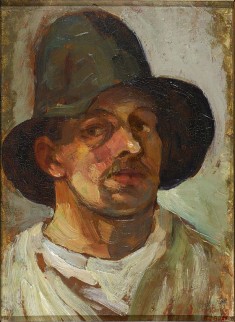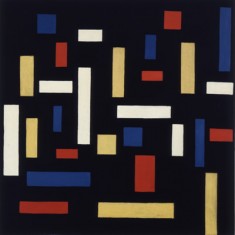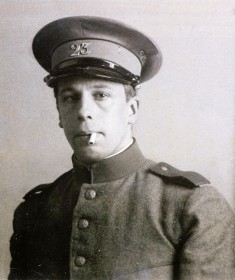Theo van Doesburg was a Dutch artist who played a major role in forming the artistic concept of De Stijl, but he also worked as an architect designing buildings and cafes for other artists.
Founder of De Stijl
Theo van Doesburg was the primary founder of the De Stijl (Dutch for The Style) art movement in the Netherlands. While there is no official date that marks the debut of the De Stijl movement, it can be traced to 1917 when Doesburg began publishing a magazine of the same name devoted to this style and theory of abstract art and architecture.
Although Doesburg is often considered the founder of De Stijl, the movement was actually the collaboration of a number of artists of his day, including Piet Mondrian. Other primary innovators of De Stijl were Vilmos Huszár, Bart van der Leck, Gerrit Rietveld, and Robert van ‘t Hoff. The latter two men were architects. The De Stijl movement was almost as much about architectural design as it was about paintings on the canvas.
Doesburg’s Early Life
Theo van Doesburg was born in 1883 in Utrecht as Christian Küpper. His father was Wilhelm Küpper and his mother was Henrietta Catherina Margadant. When he began his life as a painter, he signed his works “Theodorus Doesburg” in honor of his step-father, whom he felt was his true father emotionally. He added the “van” to his name later.
His original training was in theater and as a singer, but he soon discovered his passion for painting. Doesburg proved himself as an artist of considerable skill creating figurative pieces, largely influenced by style of Vincent Van Gogh. He was able to sell his art and his first public show was in 1908. Doesburg also earned money as a writer, poet, and art critic.
Doesburg’s Artistic Influences
 In 1913, after reading the theories of the Russian painter and intellectual Wassily Kandinsky, Doesburg became captivated by an abstract style of art that featured clean straight lines and simple geographic figures. These creations favored bright primary colors dominated by reds, whites, yellows and blacks.
In 1913, after reading the theories of the Russian painter and intellectual Wassily Kandinsky, Doesburg became captivated by an abstract style of art that featured clean straight lines and simple geographic figures. These creations favored bright primary colors dominated by reds, whites, yellows and blacks.
However, Doesburg’s largest personal influence was fellow Dutch artist Piet Mondrian, a painter who was eight years his senior. The two men became friends and together they founded De Stijl, a style of art that is sometimes called Neo-Plasticism.
The idea behind Neo-Plasticism is that true art, or the highest form of art, should not depict the ordinary scenery that we see around us every day. Rather it should be the expression of higher ideals and principles of the human spirit. Art should reflect the inner life of humanity, not the “false” illusory exterior.
Strained Relations with Mondrian
The two artists soon realized that they had different philosophies regarding the direction of lines in artwork. On one side, Mondrian considered the straight line to be of utmost importance. Doesburg, on the other hand, was introducing diagonal lines in his artwork. Mondrian considered this to be a betrayal of the De Stijl concept. This is often the reason cited for the why the two ended their friendship and professional connection.
The split between Doesburg and Mondrian has long been the topic of debate among art historians. Some maintain differences over style were the primary cause for the estrangement of the two friends, but others say it was also about a personality clash. Doesburg was an extrovert, outgoing and gregarious, whereas Mondrian was an introverted loner.

Although much is made of the rift between Doesburg and Mondrian, the two men later put aside their differences. After years of avoiding each other, they met by chance in a Paris café. They immediately put aside their differences and resumed their friendship. They continued to agree to disagree on art theory, however.
Rediscovering Doesburg
Theo van Doesburg continued to be popular during the height of his career from about 1917 until he died of a heart attack in 1931 at the age of 47. However, it was his friend and sometimes adversary, Piet Mondrian, who came to be best known as the exemplary of the Neo-Plasticism style. This was helped along by fashion designer Yves Saint Laurent, who in the 1960s leveraged Mondrian’s work to create a style of dress which featured the clean, colorful geometric shapes and colors of De Stijl. It became an iconic “mod” fashion look of the 1960s.
In the meantime, Doesburg and his work faded into the background of avant-garde art history. His work, however, is being rediscovered and newly appreciated today. The Tate Gallery in London recently conducted a show featuring the work of Theo van Doesburg which was greeted with considerable interest and praise.
